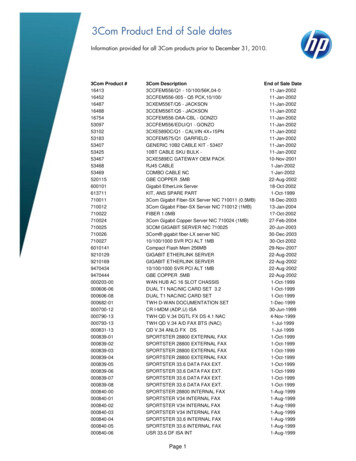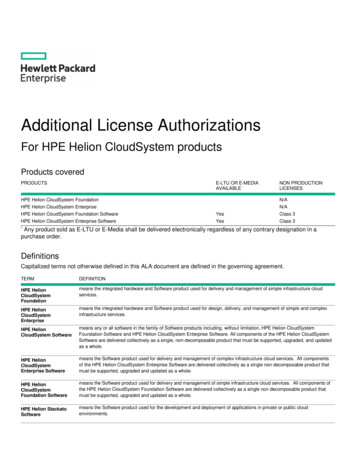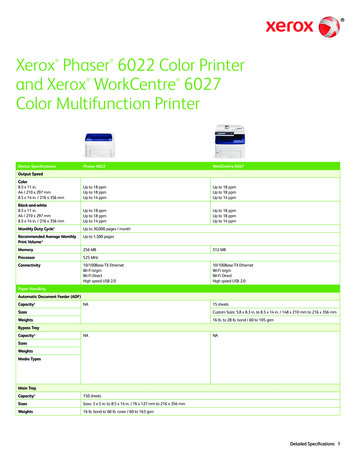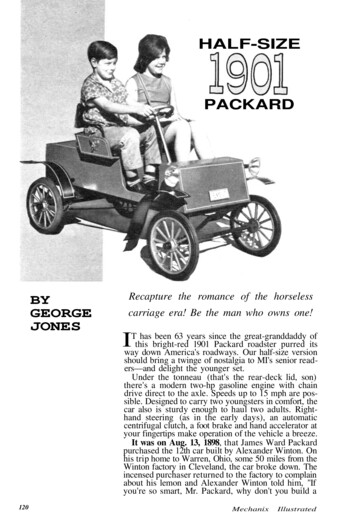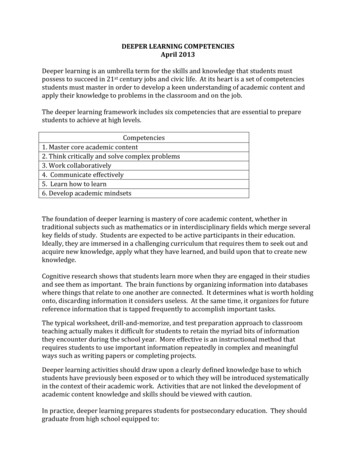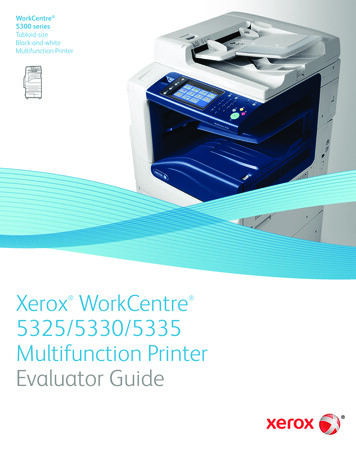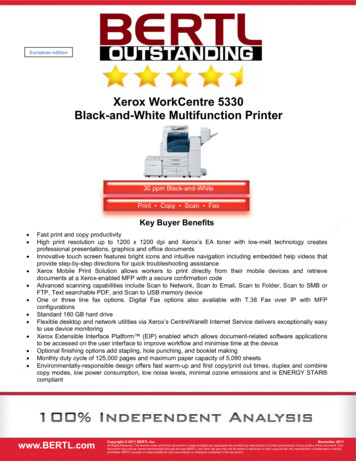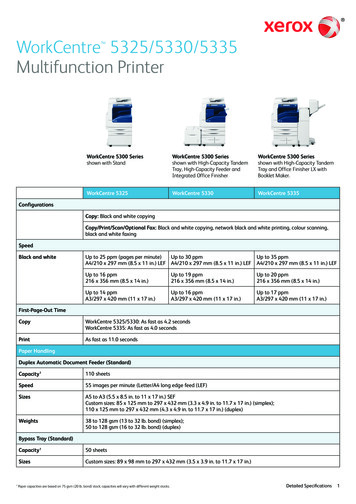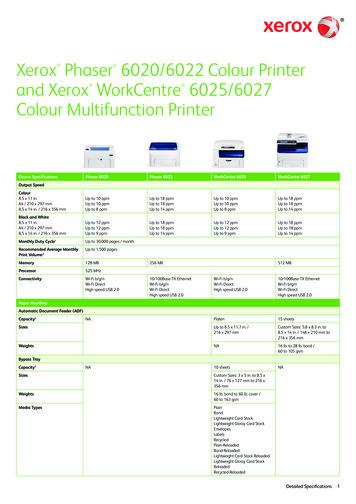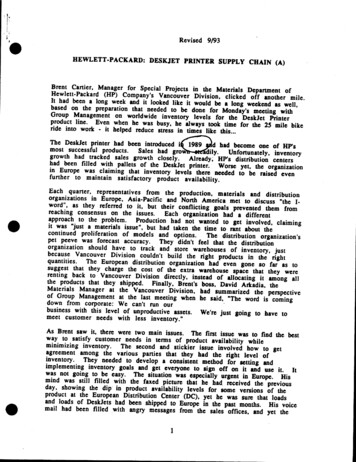
Transcription
iRevised 9/93tHEWLETT-PACKARD: DESKJET PRINTER SUPPLY CHAIN(A)Brent Cartier, Manager for Special Projects in the Materials DepartmentHewlett-Packard (HP) Company's Vancouver Division, clicked off anotherofmileIt had been a long week and it looked like it would bea longas well,based on the preparation that needed to be done for Monday'sweekendmeetingwithGroup Management on worldwide inventory levels forthe DeskJet Printerproduct line. Even when he was busy, he always took time for the 25mile bikende into workit helped reduce stress in times like this.-The DeskJet printer had been introduced i(1989 aild had become one ofHFsmost successful products.Sales had groW-*e* iily. Unfortunately, inventorygrowth had tracked sales growth closely.Already. HP'scentershad been filled with pallets of the DeskJet printer. Worsedistributionyet, the organizationin Europe was claiming that inventory levels thereneeded to be raised evenfurther to maintain satisfactory product availability.""Each quarter, representatives from the production, materials anddistributionorganizations in Europe, Asia-Pacific and North Americamet to discuss "the Iword , as they referred to it, but their conflictinggoals prevented them fromreaching consensus on the issues. Each organization had adifferentapproach to the problem. Production had not wantedto get involved, claimingit was just a materials issue", but had takenthe time to rant about thecontinued proliferation of models and options. The distribution organization'spet peeve was forecast accuracy.They didn't feel that the distributionorganization should have to track and store warehousesof inventory justbecause Vancouver Division couldn't build the right products in the rightquantities. The European distribution organizationhad even gone so far as tosuggest that they charge the cost of theextra warehouse space that they wererenting back to Vancouver Division directly, insteadof allocating it among allthe products that they shipped. Finally, Brent's boss,David Arkadia, theMaterials Manager at the Vancouver Division, had summarized the perspectiveof Group Management at the last meeting when he said,"The word is comingdown from corporate: We can't run ourbusiness with this level of unproductive assets. We're just going to have tomeet customer needs with less inventory."As Brent saw it, there were two main issues. The first issue was to findthe bestway to satisfy customer needs in terms of product availability whileminimizing inventory. The second and stickier issue involved howto getagreement among the various parties that they hadthe right level ofinventory. They needed to develop a consistent method for setting andimplementing inventory goals and get everyone to sign off on ituse it Itwas not going to be easy. The situation was especially urgent in andEurope Hismind was still filled with the faxed picture that he had received the previousday showing the dip in product availability levels for some versionsof theproduct at the European Distribution Center (DC), yet he wassurethatloadsand loads of DeskJets had been shipped to Europe inthe past months. His voicemail had been filled with angry messages from the sales offices,and yet the1
European DC was telling Vancouver that they had run out of space to storeVancouver's products.Brent parked his bike and headed for the company showers. His morningshower was another ritualthis was the time he had to review his plans forthe day and play out different scenarios. Perhaps a solution would come to-him."BackgroundHewlett-Packard Company (HP) was founded in 1939 by William Hewlett andDavid Packard, with headquarters in Palo Alto, California. It grew steadilyover the next fifty years, diversifying from its base in electronic test andmeasurement equipment into computers and peripherals products, which nowdominated its sales. In 1990 HP had over 50 operations worldwide, withrevenues of 13.2 billion and net income of 739 million.HP was organized partially by product group and partially by function (figure1). The Peripherals Group was the second largest of HP's six product groups,with 1990 revenues of 4.1 billion. The group's divisions each acted as aStrategic Business Unit for a specific set of products. Products includedprinters, plotters, magnetic disc and tape drives, terminals and networkproducts.The Peripherals Group had set technological standards with many of itsproducts, with innovations such as the disposable print head used in its inkjet printers and moving-paper plotters.While these innovations contributedto its success, the Peripherals Group was also recognized for its ability toidentify and profitably exploit market opportunities, as in the case of its mostsuccessful product, the LaserJet printer.The RetailPrinter Market"Worldwide sales of small workgroup/personal printers in 1990 were about 17million units, amounting to 10 billion. The market tracked personal computersales closely; the market was mature in the US and Western Europe but wasstill developing in Eastern Europe and in the Asia-Pacific region.Small workgroup/personal printers were sold almost exclusively throughresellers.The reseller channels were changing rapidly, particularly in theUS. Traditionally, printers had been sold through computer dealers, but aspersonal computers became commodity products, more and more sales wereflowing through superstores and consumer mass merchandisers such as XMart and Price Club.The retail printer market was composed of three technology segments:impact/dot matrix (40%), ink-jet (20%) and laser (40%). Dot matrix was theoldest technology, and was viewed as noisy and of lower print qualitycompared to the other two types. The dot matrix printer market share wasexpected to fall to 10% during the next few years as the technology wasreplaced by either ink-jet or laser printers in all applications except multipart forms and wide carriage printing.In 1989, most customers were notaware of ink-jet technology. However, customers were discovering that inkjet print quality was almost as good as laser print quality at a much more2"
"affordable price.Sales had increased dramatically. In the monochromemarket, it remained to be seen which technology would eventually dominate atthe low end. Much would depend on the pace at which technology developedin both areas, and the relativecosts.HP and Canon separately pioneered ink-jet technology at their respectivecorporate laboratories during the early 1980s. The key technologicalbreakthroughs had been ink formulation and the disposable print head. HPhad introduced its first disposable head model, the Thinkjet printer, in the late80's, while Canon had just introduced one in 1990.HP led the ink-jet market in the US, while Canon led the market in Japan.European competitors included Epson, Manisman-Tally, Siemens and Olivetti,though only Olivetti had introduced a printer with a disposable print head by1991. Some dot matrix printer companies were also starting to offer ink-jetprinter products.Ink-jet printers were rapidly becoming commodity products.The endchoosing between two ink-jet printers of equal speed and printquality, increasingly used general business criteria such as cost, reliability,quality and availability to decide. Product loyalty continued to decrease.customer,The Vancouver Division and its Quest for Zero InventoryIn"1990, Vancouver Division's mission statement read:"Our Mission is to Become the Recognized World Leader in Low Cost PremiumQuality Printers for Printed Communications by Business Personal ComputerUsers in Offices and Homes."The Vancouver Division, located in Vancouver, Washington, was established in1979. HP saw an opportunity to provide personal printers for the relativelynew, fast-growing personal computer market.HP consolidated personalprinter activities from four divisions (Fort Collins, Colorado; Boise, Idaho;Sunnyvale, California; Corvallis, Oregon) to the Vancouver site. The newdivision became part of HP's Peripherals Group and was chartered with thedesign and manufacturing of ink-jet printers.As Bob Foucoult, the production manager and one of Vancouver's firstemployees recalled, "Management was pulled from all over HP and ploppeddown in Vancouver. There was no cohesive staff and no cohesive set ofperhaps that's why we were so open to new ideas."business practices-The manufacturing organization realized early on that a fast, high-volumeprocess would be required for success in the printer market. With the current(1979) 8-12 week cycle time and 3.5 months of inventory, the VancouverDivision would be doomed to fail. They looked within HP for knowledge ofhigh-volume processes, but found none. HP, being an instrument company,only had experience building low volume, highly customized products usingbatch processes."One day in mid- 1981 two Vancouver managers happened to take seats on aplane next to two professorsRichard Schoenberger (Nebraska University)-3
and Robert Hall (Indiana University). Schoenberger had just written a roughdraft for a paper called "Driving the Productivity Machine" about amanufacturing process being used in Japan: Kanban.Vancouver'smanagement recognized the promise of this "new" manufacturing concept andRobert Hall recognized an opportunity to have his ideas tested in the US. Theydecided to work together."Within a year Vancouver had converted the factory to stockless productionand had reduced inventory from 3.5 months to 0.9 months, with a drasticreduction in cycle time. Vancouver became a showcase factory for theKanban process; between 1982 and 1985 over 2,000 executives from within andoutside HP toured the process. Vancouver impressed visitors by having themsign a raw printed circuit board as they arrived, then presenting them with afinished printer, made with that PC board using the standard process, an hourand a half later.There was one key element missing, however. As Bob Foucoult puts it,"Wewere all dressed up but had no one to take us to the dance." Vancouver had notyet introduced a successful, high-volume product that would take fulladvantage of the advanced production line. Vancouver had introducedproducts based on HP's latest ink-jet technology, but, as with any newtechnology, they had to gain experience to work the bugs out. The earlymodels had poor resolution and required special paper for printing, resultingsuccess in the market place,eings started to change. Vancouver introduced the DeskJet printer, awith near letter-quality resolution which used standard paper. Thewas a wild success. Since the manufacturing process had been inplace and had been thoroughly exercised, all that was needed was to "flip theswitch". HP's knowledge and implementation of the Ink-jet technology,combined with its streamlined manufacturing process, gave HP the edgeneeded to become the market leader in the ink-jet printer market."The DeskJet Supply ChainThe network of suppliers, manufacturing sites, distribution centers (DCs),dealers and customers for the DeskJet product comprised the DeskJet supplychain (figure 2). Manufacturing was done by HP in Vancouver.There weretwo key stages in the manufacturing process:(1) printed circuit assemblyand test (PCAT) and (2) final assembly and test (FAT). PCAT involved theassembly and testing of electronic components like ASIC's (applicationspecific integrated circuits), ROM (read-only-memory), and raw printedcircuit boards to make logic boards and print head driver boards for theprinters. FAT involved the assembly of other subassemblies like motors,cables, key pads, plastic chassis and "skins", gears and the printed circuitassemblies from PCAT to produce a working printer, as well as the final testingof the printer. The components needed for PCAT and FAT were sourced fromother HP divisions as well as from external suppliers worldwide.Selling the DeskJet in Europe required customizing the printer to meet thelanguage and power supply requirements of the local countries, a processknown as "localization." Specifically, the localization of the DeskJet fordifferent countries involved assembling the appropriate power supply module,4"
#which reflected the correct voltage requirements (110 or 220) and power cordterminator (plug), and packaging it with the working printer and a manualwritten in the appropriate language. The design of the product was such thatthe assembly of the power supply module had to be done as part of the finalassembly and test process, and therefore the localization of the printer wasperformed at the factory. Hence, the finished products of the factory consistedof printers destined for all of the different countries. These products werethen sorted into three groups destined for the three distribution centers:North America, Europe and Asia-Pacific. Figure 3 details the Bill of Materialsand the various options available.Outgoing products were shipped to the three distribution centers by ocean.In Vancouver, inventories of the components and raw materials weremaintained to meet production requirements, but otherwise, no significantbuffer inventories between the PCAT andFAT stages were kept. Managementhad continued to prefer to maintaip no fihtsfaed goods inventory at thefactory, a tradition that was started in 1985 asj described in the previoussection.\ The total factory cycle time through the PCAT and FAT stages was about a week.The transportation time from Vancouver to the US DC, located in San Jose,California, was about a day, whereas it took 4-5 weeks to ship the printers toEurope and Asia. The long shipment time to the DCs in Europe and Asia was dueto ocean transit and the time to clear customs and duties at port of entry."The printer industry was highly competitive.Customers of HP's computerproducts (resellers) wanted to carry as little inventory as possible, yetmaintaining a high level of availability to end-users (consumers) was criticalto them.Consequently there had been increasing pressure for HP as amanufacturer to provide high levels of availability at the DCs for the resellers.In response, management had decided to operate the DCs in a make-to-stockmode in order to provide very high levels of availability to the dealers. Targetinventory levels, equal to the forecasted sales plus some safety stock level,were set at the three DCs.As mentioned earlier, Vancouver prided itself as an almost "stockless" factory.Hence, in contrast to distribution, manufacturing of the DeskJet printeroperated in a pull mode. Production plans were set to replenish the DCs "justin-time" to maintain the target inventory levels. To ensure materialavailability, safety stocks were also set up for incoming materials at thefactory."There were three major sources of uncertainty that could affect the supplychain: (1) delivery of incoming materials (late shipments, wrong parts, etc.);(2) internal process (process yields and machine downtimes); and (3) demand.The first two sources of uncertainties resulted in delays in the manufacturinglead time to replenish the stocks at the DCs. Demand uncertainties could lead toinventory buildup or backorders at the DCs.For the European and Asian DCs,since finished printers were shipped from Vancouver by ocean, theconsequence of the long lead time was that the DCs ability to respond tofluctuations in the demand for the different versions of the product waslimited. In order to assure high availability to customers, the European andAsian DCs had to maintain high levels of safety stocks. For the North American5
DC the situation was simpler; since an overwhelming majority of the demandswas for the US version there was little localization-mix fluctuation.TheDistributionProcessAt HP, while a typical DC shipped hundreds of different peripheral andsmall number of products accounted for a large share ofthe volume. The DeskJet printer was one of these high volume products."computer products, aThe Operations Manager of each regional DC reported into a WorldwideDistribution Manager, who reported to both the Peripherals Group Manager(peripherals made up the bulk of shipments through distribution centers) andto HP's Vice President of Marketing (figure 1). Each Operations Manager had astaff of six functional managers, representing Finance, MIS, Quality,Marketing, Physical Distribution and Distribution Services. The first threefunctions were similar to their respective functions in a manufacturingorganization.Marketing was responsible for interactions with customers.Physical Distribution was responsible for the "physical process", i.e., fromreceiving through shipping.Distribution Services was responsible forplanning and procurement.The major performance measures for a typical DC included Line Item Fill Rate(LIFR) and Order Fill Rate (OFR). LIFR was calculated as the total number oforder line items filled divided by the total number of customer lineitems attempted. (Each time HP tried to pull material for a line item, it wascounted as an attempt.) OFR was a similar measure, but was based on orderscompleted, where an order contains multiple line items. Secondaryperformance measures included inventory levels and distribution cost pergross shipment dollar.The two major costs were outbound freight andsalaries. Freight was charged back to the product fines based on the actualnumber of pounds of product shipped. In addition, the DC estimated the"percentage of effort" required to support a particular product line andcharged that percentage of non-freight costs back to that product line. Thesystem was somewhat informal, and major negotiations took place between theDCs and the major product lines during the budget-setting process todetermine the percentage allocation that was appropriate for each productcustomer"line.The DCs had traditionally envisioned their process as a simple , straight-line,standardized process. There were four process steps:1) Receive (complete) products from various suppliers and stock them2) Pick the various products needed to fill a customer order3) Shrink wrap the complete order and label it4) Ship the order via the appropriate carrier.The DeskJet printer fit well into the standard process. In contrast, otherproducts, such as personal computers and monitors, required specialprocessing, called "integration", which included addition of the appropriatekeyboard and manual for the destination country. Although this extraprocessing didn't require much extra labor, it was difficult to accommodate inthe standard process and disrupted the material flow. Furthermore, the DCs'6"
"materials management systems supported distribution (pass-throughprocessing of "end-items" in the form of individual models and options) anddid not support manufacturing (assembly of componentsinto a final product)There were no MRP (Material Resource Planning) nor BOM (Bill of Materials)explosion systems, and the DCs did not have adequate people trained incomponentprocurement.There was considerable frustration within the distribution organizationregarding the support of assembly processes. In general, top managementstressed the DCs role as a warehouse, and the need to continueto "do what theywere best at distribution." Tom Beal, the US DCMaterials Manager expressedthe general concern when he said," We have to decide what our corecompetency is and what value we add. We need to decide whether weare in thebusiness of warehousing or integration, then adopt strategies to supportourbusiness. If we want to take on manufacturing processes (here) wehavetoput processes in place to support them."-The Inventory andService CrisisTo limit the amount of inventory throughout the DeskJet supply chainsame time provide the high level of service needed had been quite andchallenge to Vancouver's management. The manufacturing group in aVancouver had worked hard on supplier management to reduce theuncertainties caused by delivery variabilities of incoming materials, onimproving process yields and on reducingdowntimes at the plant. Theprogress made had been admira
i t " " 1 Revised 9/93 HEWLETT-PACKARD: DESKJET PRINTER SUPPLY CHAIN (A) Brent Cartier, Manager for Special Projects in the Materials Department of Hewlett-Packard (HP) Company's Vancouver Division, clicked off another mile It had been a long week and itlooked like itwould be a long weekend as well, based on the preparation
